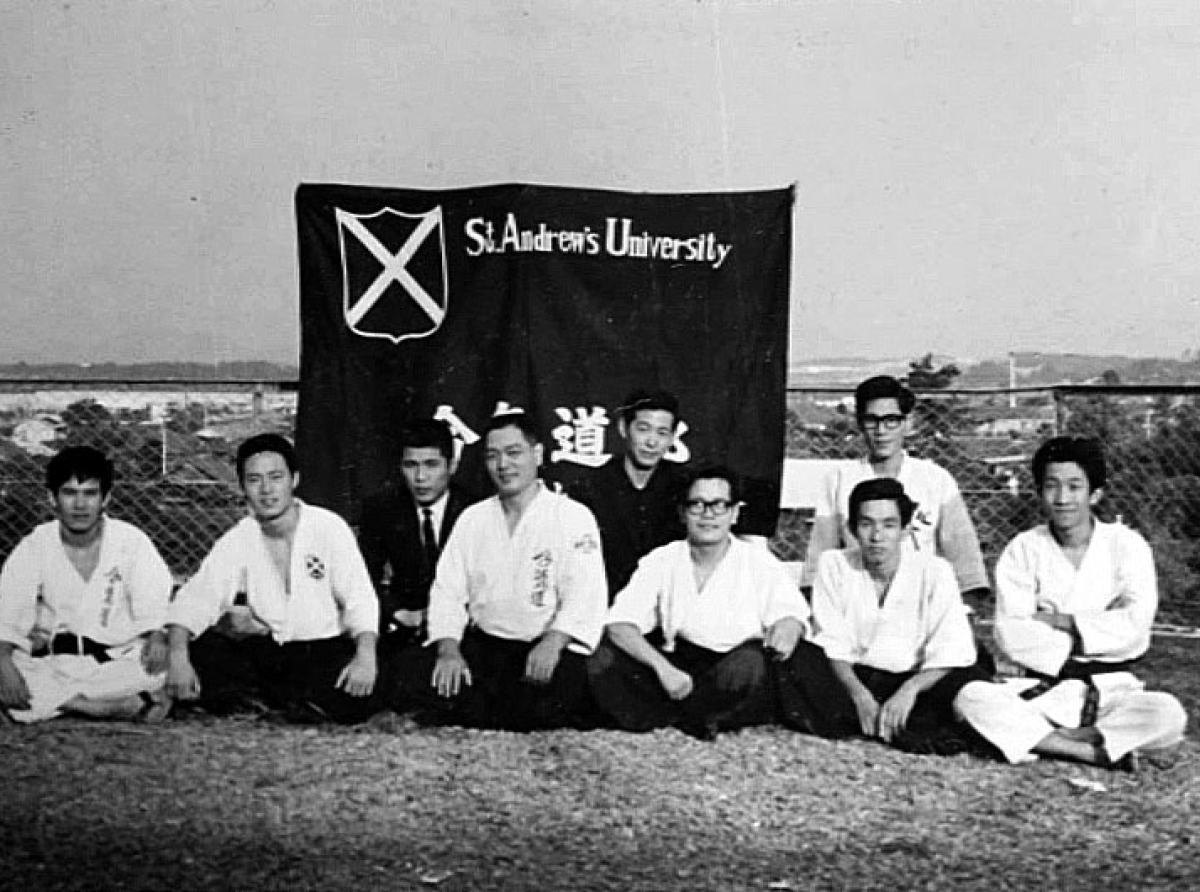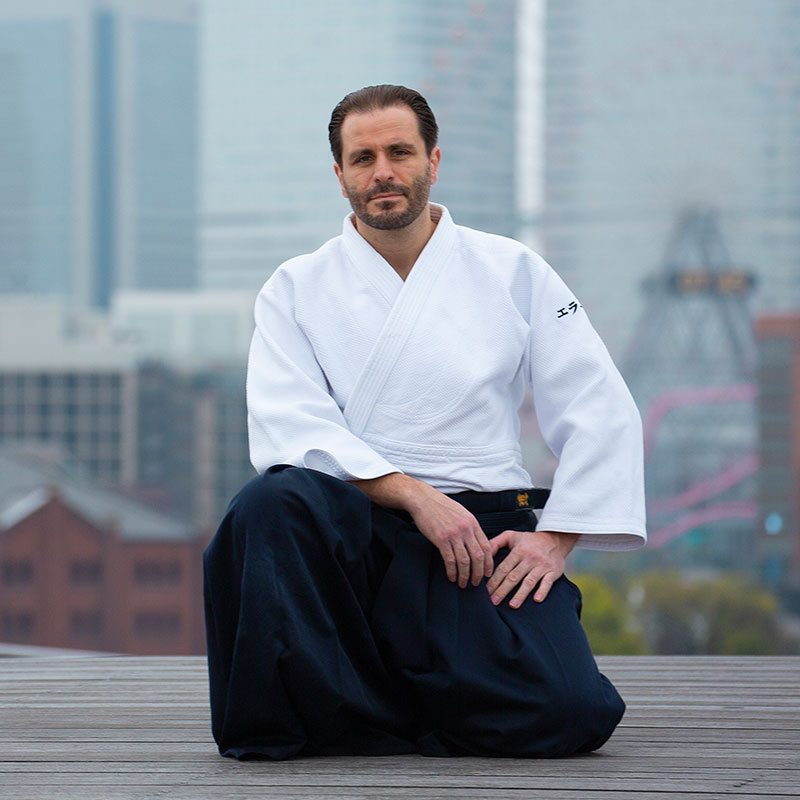Some time ago, Aikido Journal published excerpts from an email exchange between the late Stanley Pranin and André Cognard, who runs an independent Aikido group in Europe. The article highlights a so-called unknown connection between Mr Cognard’s teacher, Kobayashi Hirokazu, who was a post-war Aikido student of Ueshiba Morihei, but also Hisa Takuma, who learned Daito-ryu Aiki-jujutsu from Ueshiba at the Osaka Asahi Newspaper in the early thirties. This publication caught my attention because I am a student of both Aikido at the Aikikai Hombu Dojo and of Daito-ryu Aiki-jujutsu in a line that carries on Hisa’s teachings. In this article, I would like to offer additional background on this connection and examine the conclusions that can reasonably be drawn from the facts at our disposal, some of which that differ substantially from what has been published here so far.
First, this post-war connection is true and it is in fact pretty common knowledge among the Daito-ryu practitioners of the Kansai area. So even though it is not news, it is very valuable to bring its existence to the attention of the public since it shows that Daito-ryu Aiki-jujutsu and Aikido share extensive common history, and that some of their respective groups stayed in active contact well after the end of practice at the Asahi Journal in the late thirties, and the formal split between Ueshiba Morihei and his teacher Takeda Sokaku.
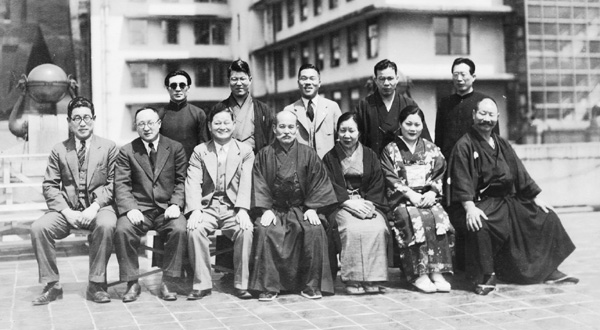 Ueshiba Morihei in front of the Osaka Asahi Newspaper. On his right is the study group’s leader, Hisa Takuma (1935).
Ueshiba Morihei in front of the Osaka Asahi Newspaper. On his right is the study group’s leader, Hisa Takuma (1935).
One instance where my conclusions differ from what has been published so far lies in Kobayashi Hirokazu’s actual role as an instructor. Mr. Cognard previously suggested that his teacher was a Daito-ryu Aiki-jujutsu Shihan:
For a while he [Kobayashi Hirokazu] was a chief instructor of Daito in the Kansai. He was a shihan. André Cognard – Interview with André Cognard (2) by Stanley Pranin, June 24, 2013
The point was also referenced in the letter he wrote to Stanley, and interestingly, he cited as converging evidence an article that I had published on my own website:
During our meeting, I spoke to you about the fact that my teacher, Hirokazu Kobayashi Sensei, had been a Daito-ryu shihan active in the Kansai area. You asked me if there were any links between him and the Takumakai. I was not able to clearly answer at that time, but I checked into the matter. I found the answer in an interview with Kiyohiro Kobayashi, Director of the Takumakai, conducted by Olivier Gaurin. André Cognard – Aikido and Daito-ryu in Osaka: The Unknown Connection between Takuma Hisa and Hirokazu Kobayashi – Aikido Journal, February 3, 2015
Mr. Cognard refers to an interview that Olivier Gaurin and I had previously made with our own Daito-ryu Aiki-jujutsu instructor, Kobayashi Kiyohiro, who is an 8th dan instructor and one of the most senior students of Hisa Takuma. I remember that at the time we did this interview, the mentioning of Kobayashi Hirokazu piqued my curiosity. I can see how Mr. Cognard would too have been particularly interested to hear about his teacher when he read this interview. I do not know what previous evidence he had at his disposal to conclude that his teacher had been a Daito-ryu Shihan, and it would be fantastic if Mr Cognard could give us more information on that, because based on Kobayashi Kiyohiro’s words alone, I do not think that we can go that far:
The technical director [of Aikido] for Kansai was [Ueshiba] Kisshomaru Sensei but the club was still under the supervision of Hisa Takuma Sensei. It is Hisa Sensei who asked Kobayashi Hirokazu Sensei to be the Aikikai person in charge of the club since in the past, Kobayashi had studied with Hisa Sensei. So that is how everything got arranged. The club became an Aikido club and everybody switched from Daito-ryu to Aikido. Kobayashi Kiyohiro – Interview with Kobayashi Kiyohiro, Manager of the Takumakai by Guillaume Erard and Olivier Gaurin , October 2011
The background
After the war, Kobayashi Hirokazu spent several years in Tokyo studying Aikido at the Aikikai Hombu Dojo while working as a lacquerer. After returning to Osaka in 1954, he set himself up as a professional Aikido instructor and he even received the visit of Ueshiba Morihei on several occasions. As one of the official representatives of the Aikikai in Osaka, he was under the tutelage of Ueshiba Kisshomaru, who was Director of the Aikido World Headquarters. It is in this capacity that Kobayashi Hirokazu was subsequently asked by Hisa to turn the Momoyama Gakuin University Daito-ryu Club into an Aikido club so that it could be incorporated to the Kansai Student Aikido Federation, since no such thing existed for Daito-ryu.
 Kobayashi Kiyohiro (left) and Kobayashi Hirokazu (right) in front of the Momoyama Gakuin University Aikido Club sign.
Kobayashi Kiyohiro (left) and Kobayashi Hirokazu (right) in front of the Momoyama Gakuin University Aikido Club sign.
Therefore, the club became totally separated both technically and administratively from Hisa’s Daito-ryu Aiki-jujutsu group. In the same interview, Kobayashi Kiyohiro states the following:
Personally, I was not too happy about only doing Aikido and that is why I continued to do both Daito-ryu and Aikido at the dojos which I mentioned earlier [i.e. Hisa Takuma’s dojo, and the Momoyama Gakuin University Aikido Club, respectively]. Kobayashi Kiyohiro – Interview with Kobayashi Kiyohiro, Manager of the Takumakai by Guillaume Erard and Olivier Gaurin, October 2011
This confirms that the practice under Kobayashi Hirokazu at Momoyama Gakuin University was totally distinct from that of Hisa Takuma at the Kansai Aikido Club. I must mention that although the name suggests that Hisa’s club was an Aikido club, it actually held Daito-ryu Aiki-jujutsu classes. Hisa likely chose that name because the name Aiki-jujutsu was not well known and would not have drawn many students in. As a holder of a Daito-ryu Aiki-jujutsu menkyo kaiden (certificate of full transmission) from Takeda Sokaku, Hisa was in fact only entitled to award Daito-ryu ranks, not Aikido.
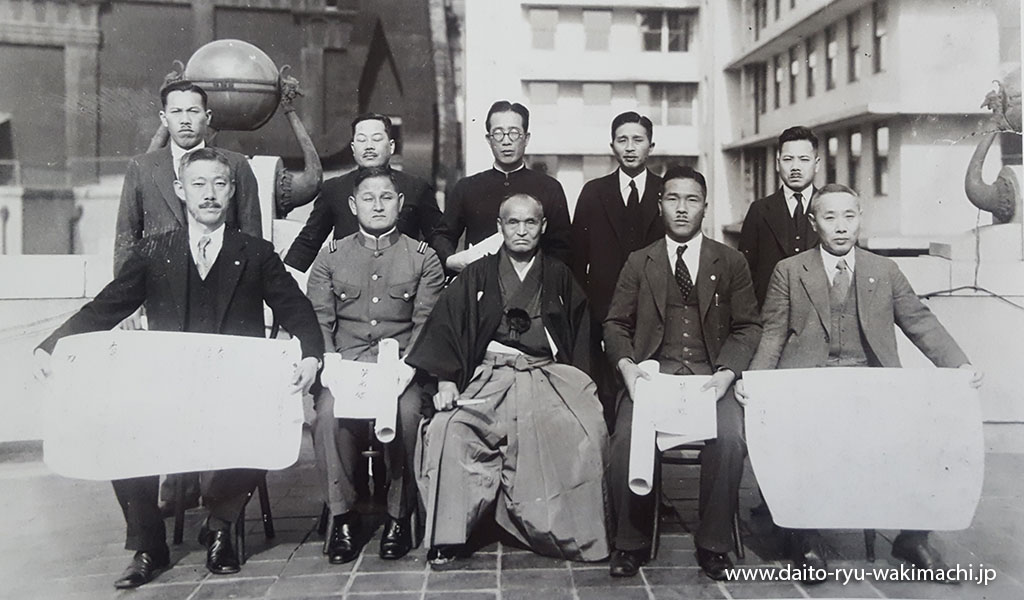 Asahi Newspaper group with their certificates around Takeda Sokaku. Hisa is sitting at Sokaku’s right (c. 1937). Source: Daito-ryu Aiki-jujutsu Shikoku Hombu.
Asahi Newspaper group with their certificates around Takeda Sokaku. Hisa is sitting at Sokaku’s right (c. 1937). Source: Daito-ryu Aiki-jujutsu Shikoku Hombu.
It is important to note that the Japanese are sometimes a little inconsistent in their use of terminology. For instance, Daito-ryu practitioner in Kansai do often use the term Aikido to refer to their practice, but it is in no way to refer to Ueshiba’s Aikido. This loose use of terms is of course often quite confusing and it could have been one of the elements that led Mr. Cognard to assume that his teacher was in charge of Daito-ryu in Kansai.
In order to really find out what Kobayashi Kiyohiro had in mind when he said that Kobayashi Hirokazu learned from Hisa, I went back to ask him to clarify. He replied the following:
He [Kobayashi Hirokazu] learned some [Daito-ryu from Hisa] but it was only for a brief period though. Kobayashi Kiyohiro – Interview with Kobayashi Kiyohiro by Guillaume Erard, August 2018
Kobayashi Kiyohiro made it clear once again that technically, the Daito-ryu of Hisa and the Aikido of Kobayashi Hirokazu were different. In fact, as far as similarities that exist between Daito-ryu and Aikido, Kobayashi Kiyohiro often tends to mention that training at Shioda Gozo’s Yoshinkan was closer to what he did with Hisa than any Aikikai dojo.
In order to get the most complete picture possible, I decided to get further information from the Aikido side, via people who had been actual students of Kobayashi Hirokazu in Kansai at the time. I talked to Kimura Jiro Shihan, who is an 8th dan Aikido instructor based in Osaka, and the successor of Kobayashi Hirokazu in Japan. Here is what Kimura Sensei told me when I asked him whether his teacher learned formally from Hisa:
Rather than learning from him he must have seen some techniques and used them as reference. Kimura Jiro – Interview with Kimura Jiro part 2 by Guillaume Erard, August 2018
During our conversation, Kimura Sensei went on to confirm that there was no evidence to suggest that Kobayashi Hirokazu ever took part in the training at the Kansai Aikido Club, let alone that he was a shihan in the art, or in charge of Daito-ryu in the Kansai area or anywhere else. Interestingly, when I visited Kimura Shihan’s office, I noticed that he had in his bookshelf a copy of the Soden, which is a technical book compiled by Hisa to document the Daito-ryu techniques that he learned from Ueshiba Morihei and Takeda Sokaku at the Asahi Newspaper. I asked Kimura Sensei whether he was familiar with the material contained in the book and he replied that he had never studied to its content, and that all he knew were the parts of it that were performed by Mori Hakaru Sensei (the current director of the Takumakai) and others senor instructors during demonstrations.
We see that there seems to be a consensus between authorities on both the Daito-ryu and the Aikido side, but just in case, I decided to inquire to two other direct students of Hisa from the Kansai Aikido Club era and they respectively stated the following:
Hirokazu Kobayashi is not a student of Hisa. He isn’t Takumakai. Personal communication with one of the Hisa Takuma’s senior students of the Kansai Aikido Club, August 2018
I can’t imagine that Hirokazu Kobayashi was exposed enough to Daito-ryu. He just took care of Kiyohiro Kobayashi and Takeshi Kawabe’s Aikido club as one of his Aikido branch dojo and taught them Aikido. Personal communication with another of the Hisa Takuma’s senior students of the Kansai Aikido Club, August 2018 I also need to point out that the cordial relationships between Hisa's group and the Aikikai representatives in Japan are particularly evident with the Osaka Aikikai, which the historical representative of the Aikikai in Osaka founded in 1936 by Tanaka Bansen.
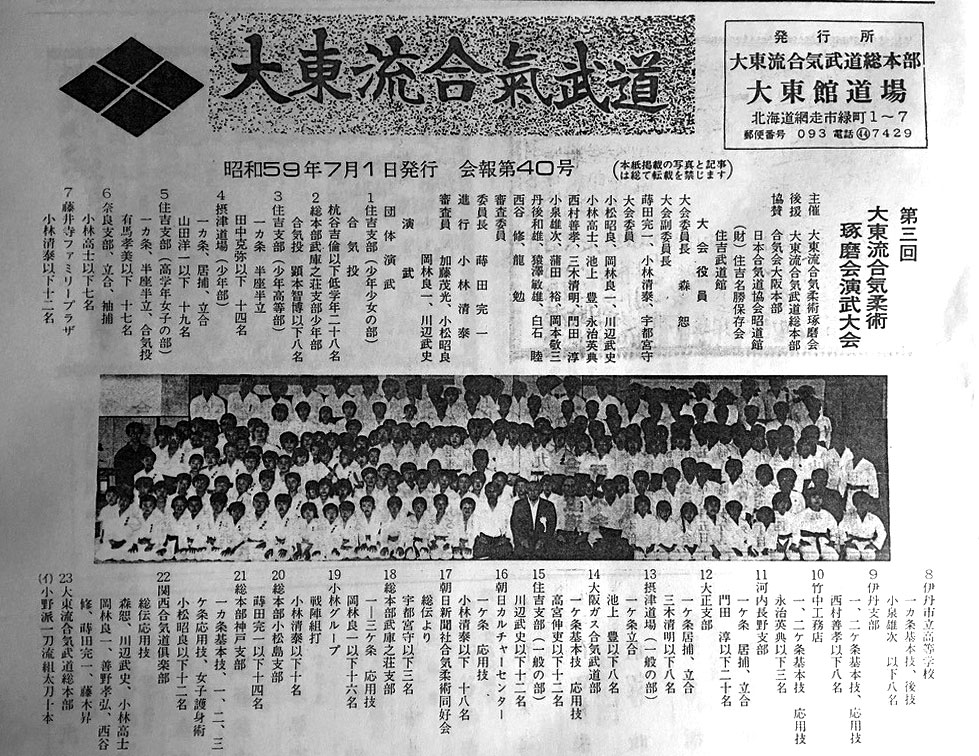 Front page of the Daito-ryu Aiki-budo newsletter issue of July 1984. It reports on the 3rd Daito-ryu Aiki-jujutsu Takumakai Demonstration with as special guest, the Aikikai Osaka Headquarters, the group headed by Tanaka Bansen. Excerpt kindly provided by Marc Trudel.
Front page of the Daito-ryu Aiki-budo newsletter issue of July 1984. It reports on the 3rd Daito-ryu Aiki-jujutsu Takumakai Demonstration with as special guest, the Aikikai Osaka Headquarters, the group headed by Tanaka Bansen. Excerpt kindly provided by Marc Trudel.
The story so far
To summarize, yes, Kobayashi Hirokazu may have picked up some techniques from Hisa Sensei at some point, but it was for a short period and probably rather informally. Considering the extensiveness of the Daito-ryu curriculum, and the time that it takes to master it, it is unlikely that Kobayashi Hirokazu would have learned sufficiently to be allowed to teach. On the other hand, Hisa was actually well known for his tendency to teach either “Aikido style” or “Daito-ryu style”, depending on the context and the audience. Kobayashi Hirokazu being a student of O-Sensei and an official representative of the Aikikai, one can suspect that Hisa might have showed him material that was congruent with that of O-Sensei. This way of adapting the material taught to each student is actually quite common with Daito-ryu teachers.
From my point of view as a student of both Aikido and Daito-ryu Aiki-jujutsu, I personally see much more post-war Aikido than Daito-ryu in the techniques of Kobayashi Hirokazu, based on what is available on video. Of course, it is of rather limited value to judge such things based on videos, but I was recently invited to teach in a European dojo founded by senior students of Kobayashi Hirokazu and I got the same impression when I practiced with them. This feeling was reinforced when I participated in trainings in Osaka under Kimura Shihan. It is undeniable however that there are quite interesting, discrete elements in the practice of Kobayashi Hirokazu and his students, which are somewhat reminiscent of Daito-ryu. All of this of course makes sense given that the connection did exist, but those elements only make a small part of their practice and as far as I can tell, they do not seem to be organized and interconnected in the way they are in Daito-ryu techniques.
What of the rest of the letter?
There is a fascinating section in this letter where Mr. Cognard relates one of his personal experiences some Daito-ryu practitioners:
Recently, I gave classes at a seminar in which various schools participated including Takumakai students and the shihan of Daito-ryu in Europe. At the end of the seminar, they asked me how long I had practiced Daito-ryu since they saw their techniques in mine. André Cognard – Aikido and Daito-ryu in Osaka: The Unknown Connection between Takuma Hisa and Hirokazu Kobayashi – Aikido Journal, February 3, 2015
I personally have had the very same experience as he did when I started Daito-ryu. Some Takumakai members in Osaka kept referring to me as their sempai because I had started Aikido before they took up Daito-ryu. Once again, we see that the distinction between Aikido and Daito-ryu as two separate names may not be as strict as we think in the mind of some of the Daito-ryu folks. Furthermore, they kept congratulating me on my Daito-ryu technique but in my case, it says more about the Japanese politeness and their self-deprecating manners, than the quality of my technique.
High level Aikido and Daito-ryu tend to look similar but I am often told by my Daito-ryu teachers that the mechanics behind them are different. Though Mr. Cognard is undeniably very advanced in Aikido, the level of the people who made those remarks to him is unclear. It would be interesting to know whether they would have been at a sufficient level to perceive the more subtitle aspects of his practice. I have not yet had the chance to ask the senior European Takumakai instructors whether they were the ones who made those comments but it would be very interesting to know in which way what they saw reminded them of their own practice, as it would lead us towards some very interesting areas of analysis in terms of whether what powers high level Aikido is the same what does Daito-ryu.
Perhaps the most potentially groundbreaking of Mr. Cognard’s assertions is that Takeda Tokimune, the son of Takeda Sokaku, regarded Kobayashi Hirokazu as the greatest expert of Daito-ryu:
One day, I heard Tokimune Takeda say, “Your master is the greatest expert of Daito-ryu I know.” Traditionally five pins are taught, Kobayashi Sensei taught 12. André Cognard – Interview with André Cognard (2) by Stanley Pranin, June 24, 2013
Takeda Tokimune succeeded his father after his passing and he was the headmaster of Daito-ryu at the time he would have said this to Mr. Cognard. If genuine, this statement would carry enormous repercussions on the entire main line of Daito-ryu. It would be interesting to check whether that claim can be confirmed by any student of Takeda Tokimune, but so far, it seems that it has only come from Mr Cognard. Being outside of that particular line of Daito-ryu, I decided to ask for clarification to Antonino Certa and Emmanuel Clérin, two Daito-ryu Shihan from the Takeda Tokimune line who reside in Europe and they answered the following:
I only know that in all my travels to Abashiri, the elderly students of Tokimune Sensei have never talked about this or Mr. Cognard. If really Tokimune Sensei, and I do not believe he did, said these words, the old Daito-kan seniors students would have remembered this person. Also, the nafudakake (a name plate rack displayed in a dojo and containing the name of the students) of the old Daito-kan dojo, and that of the Nakagawa Ise Budokan did not bear his name. Antonino Certa – Private communication, December 2018
I do not understand the connection between Kobayashi Hirokazu and Daito-ryu and even less so with Takeda Tokimune. He was a pupil of Ueshiba Morihei and I have never heard any mention of his practice of Daito-ryu from any of the senior students of Tokimune. Emmanuel Clérin - Private communication, January 2019
So it seems that regardless of the relationship between Koabayashi Hirokazu and Takeda Tokimune, the former was not a formal student of the latter. I have also looked into Tokimune's eimeiroku (the registry in which Sokaku and Tokimune entered the names of the people who studied with them) available in Aikido Journal's archives and I could not find his name, when for instance, Kobayashi Kiyohiro's name is written in it.
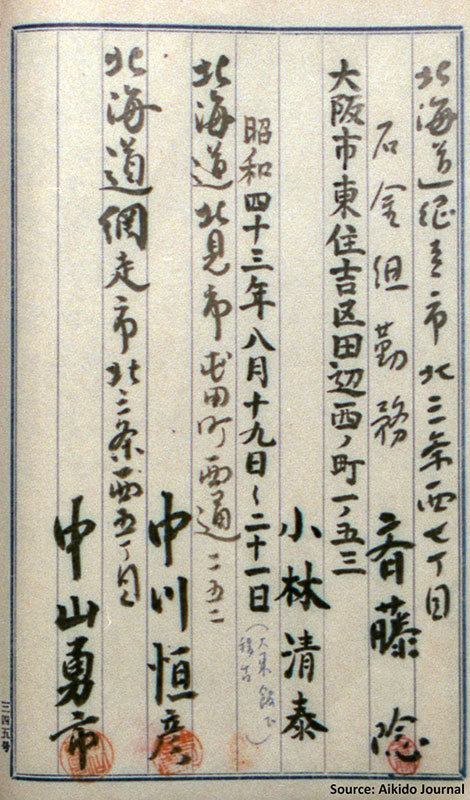 Excerpt from the Takeda eimeiroku showing the name of Kobayashi Kiyohiro.
Excerpt from the Takeda eimeiroku showing the name of Kobayashi Kiyohiro.
Concerning the statement about number of pins, they responded:
Nobody in Abashiri has ever counted the number of pins. As you well know, we trained on the 118 techniques of hiden mokuroku. And should we really count them, which I do not do, the number would be much higher than twelve. Antonino Certa – Private communication, December 2018
I do not understand this point about five pins, are we talking about what will become ikkyo, nikyo, sankyo, yonkyo and gokyo? Based on Tokimune's advanced teachings, you will find at least half a dozen pins in ikkajo alone. Emmanuel Clérin - Private communication, January 2019
I have asked my own Daito-ryu teachers and none of them seemed to know what those twelve versus five pins might mean. Given the opportunity, it would be interesting to know in which circumstances Takeda Tokimune talked to him and what he thought Tokimune meant when he made that statement to him.Here is a follow up comment that André Cognard made upon reading my article: "On the assumption that Master Kobayashi was an expert and Shihan of Daito-ryu, I might have extrapolated from the meeting I mentioned in the interview with Stanley Pranin. At an event with Master Tokimune Takeda, he told me aside, Sensei having left us for a few minutes while we were having diner together, that he was a great expert of Daito-ryu. Regarding Kobayashi sensei's supposed "expertise", judging from Mr. Erard's evidence, it was probably a eulogy on the qualities of my master to the young student I was. My enthusiasm at that time probably made me take for face value what was actually just a courtesy from master Tokimune Takeda." André Cognard - Private Communication with Josh Gold, January 17, 2019
To conclude this analysis, though this it is not directly linked to Daito-ryu, I feel that another passage warrants some attention:
I think the Aikikai made every effort to erase Hirokazu Kobayashi from the history of Aikido. Because the Aikikai officially recognized Kobayashi Sensei’s links to Takuma Hisa, it was easy to say that he was doing Daito-ryu rather than Aikido, and delete him from the list of students of Morihei Ueshiba. André Cognard – Aikido and Daito-ryu in Osaka: The Unknown Connection between Takuma Hisa and Hirokazu Kobayashi – Aikido Journal, February 3, 2015
I know very little about the various ups and downs of the relationship between Kobayashi Hirokazu and the Aikikai. It is a subject that few of his students are willing to discuss on the record and it goes well beyond the scope of this article, but it seems that Kobayashi Hirokazu was promoted to the 8th dan by the Aikikai in 1970, which was after the passing of O-Sensei. He was also present with Ueshiba Kisshomaru and the other Aikikai shihan during the first International Aikido Federation congress that was held in Tokyo in 1976. My understanding is that Kobayashi Hirokazu remained an Aikikai shihan all his life.
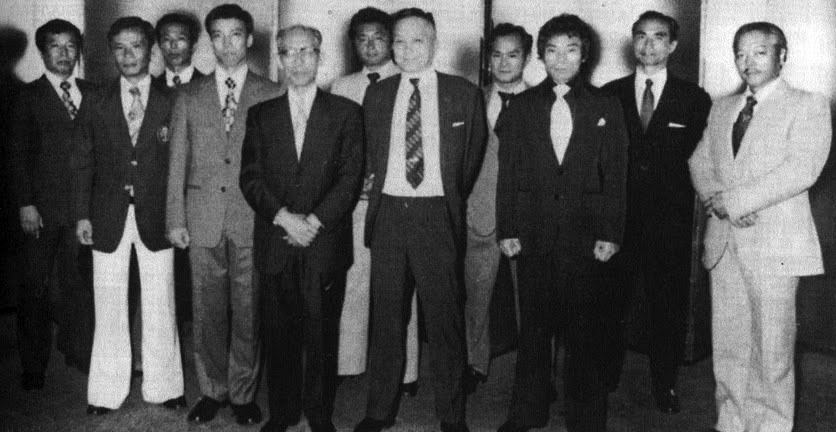 First Congress of the International Aikido Federation held in Tokyo in 1976. Kobayashi Hirokazu is at the far right.
First Congress of the International Aikido Federation held in Tokyo in 1976. Kobayashi Hirokazu is at the far right.
Undoubtedly, some tensions with the Aikikai did seem to have arisen, but the reason that was most consistently brought forward to me was the fact that Kobayashi Hirokazu started to give grades outside of the framework of the Aikikai. For instance, he awarded the 7th dan to André Nocquet in 1973danhe awarded the 7th dan to André Nocquet in 1973, at a time when Nocquet himself and the Aikikai had parted ways.
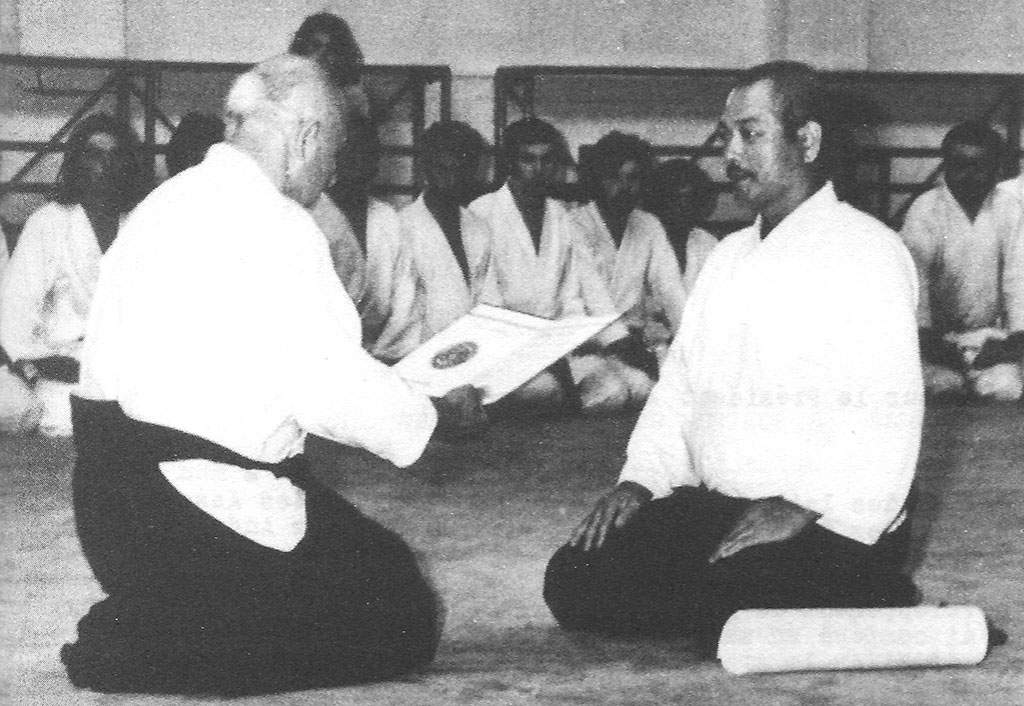 Kobayashi Hirokazu awarding the 7th dan from his own organization, the Aikido Osaka Hombu to André Nocquet on July 6, 1973.
Kobayashi Hirokazu awarding the 7th dan from his own organization, the Aikido Osaka Hombu to André Nocquet on July 6, 1973.
Mr Cognard himself was awarded the 8th dan by Kobayashi Hirokazu outside of the Aikikai framework in 1997. Of all connections, I would also tend to assume that Kobayashi Hirokazu’s relationship with Tomiki Kenji, which Mr Cognard himself talked about in Aikido Journal, would have been a lot more likely to put him at odds with the Aikikai. Though I do not intend to investigate this particular matter further, those facts seem more likely explanations for the occurrence of some tensions - and again, Kobayashi Hirokazu remained within the Aikikai all his life - than his very debatable studentship under Hisa much, much earlier.
As someone with an interest for Aikido history, and especially the Asahi Shinbun period, I feel that it is important to paint the most accurate picture possible in the light of the evidence at our disposal. It is a truly essential period for the development of Aikido and it deserves careful study and measured interpretation of the facts. I would like to make it clear that this article is not meant as an attack on Mr. Cognard, nor a criticism of his legitimacy as a teacher. I have never met Mr. Cognard personallyIt must be noted that since the publication of this article, I have had the opportunity to meet Mr Cognard over an extended lunch. We talked at length about this topic and others and it was an extremely pleasant meeting. with Mr Cognard and , nor any of his direct students. By all accounts, he is a very competent instructor and his school is well regarded. Indeed, I feel that his particular lineage might bear some additional elements of answer to the question of what makes Aikido its own thing, rather than just a style or a diminished form of Daito-ryu. In fact, Mr. Cognard was kind enough to read my article before publication and he communicated me, via Josh Gold, the editor of Aikio Journal, his appreciation for my work.
I salute Mr. Erard's investigative work on this project. One can only bow to such evidence. I thank him for opening this door to dialogue. André Cognard - Private Communication with Josh Gold, January 17, 2019
In my turn, I would like to thank André Cognard for his intellectual honesty and open-mindedness, as well as Josh Gold for ensuring that this work leads to a positive outcome for all parties and that it can serve as an example for the whole Aikido community.
I have described here the evidence that I had, and provided my own interpretations. I will be happy to reconsider my own conclusions and stand corrected if any new or contradictory evidence is brought forward. I will edit this article accordingly as further evidence is made available, feel free to point to it or discuss it in the comment section below.

